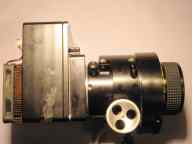The control board is powered from a 12-18V DC supply (which
shares the RJ-12 connector with the serial port). In addition to the serial
port, the schematic has provisions for a SBIG-style pulse input to control
the wheel. This option is not yet implemented in the firmware however.
The following design files are provided for download:
Control circuit schematics (pdf)
Parts list (text)
Filter wheel firmware (tar.gz)
README file




